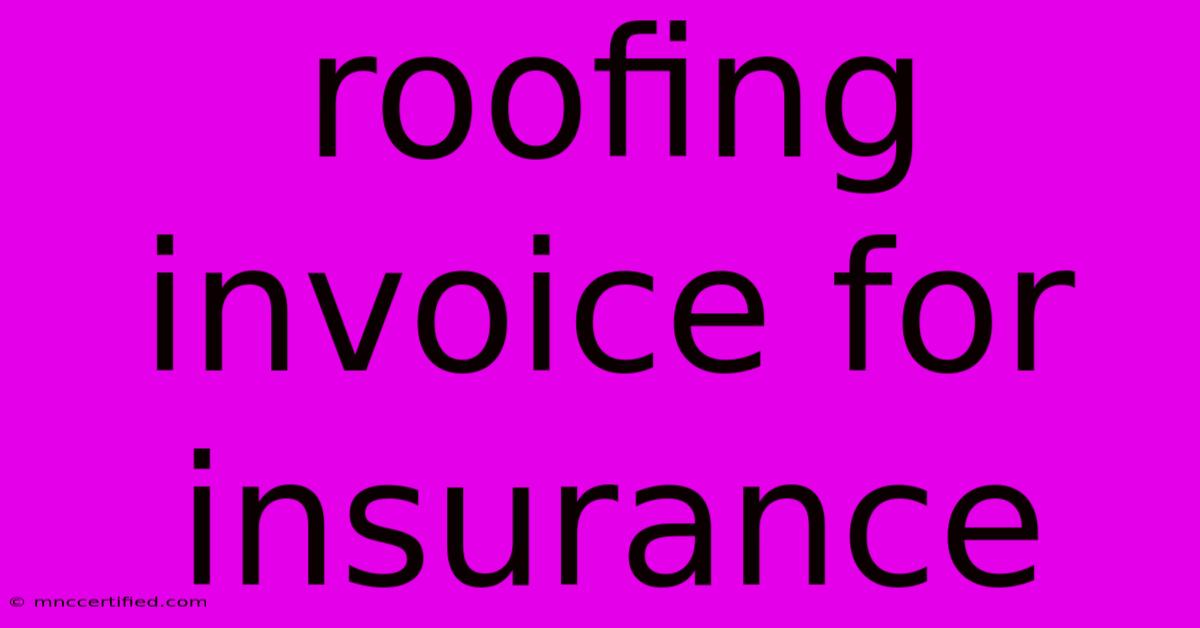Roofing Invoice For Insurance

Table of Contents
Roofing Invoice for Insurance: A Comprehensive Guide
Getting your roof repaired or replaced is stressful enough, but navigating the insurance claim process afterward can feel like navigating a minefield. A crucial element in this process is the roofing invoice for insurance. This isn't just any invoice; it's a critical document that determines how much your insurance company will reimburse you. A poorly prepared invoice can lead to delays, denials, or even underpayment. This comprehensive guide will walk you through everything you need to know about creating a winning roofing invoice for insurance purposes.
What Makes a Roofing Invoice Insurance-Ready?
A standard invoice simply won't cut it. Your insurance company needs specific information to process your claim efficiently. Here's what your invoice must include:
-
Detailed Description of Services: Don't just list "roof repair." Specify the materials used (e.g., "CertainTeed Landmark Pro shingles, 30-year warranty"), the number of squares replaced, the type of repairs performed (e.g., "removal and replacement of damaged shingles," "flashing repair," "gutter repair"), and any other relevant details. The more detail, the better. Think of it as a mini-project report.
-
Accurate Quantities and Pricing: Clearly state the quantity of each material used and its corresponding price. Avoid vague terms like "miscellaneous materials." Each item should have a separate line item with a unit price and total cost. This allows for easy verification by the insurance adjuster.
-
Contractor's Information: This includes your name, address, phone number, email address, and business license number. It's also crucial to include your contractor's insurance information, including your liability and workers' compensation insurance policy numbers.
-
Policyholder's Information: Your name, address, policy number, and date of loss are all essential.
-
Date of Service: Clearly indicate the dates the work was performed.
-
Payment Terms: Specify your payment terms, including the due date. While this might seem secondary to the insurance claim, it maintains professional standards.
-
Total Cost: The total amount due, clearly stated.
-
Itemized Breakdown of Costs: This goes beyond simply listing materials. Detail labor costs separately, and potentially breakdown labor by task (e.g., tear-off, underlayment installation, shingle installation).
-
Photographs and Documentation: Although not directly on the invoice, include references to photos and other documentation supporting the claim (damage assessment, before & after photos, etc.). This helps build a stronger case.
-
Specific Damage Caused by Insured Peril: Explicitly state the damage was due to a covered peril (e.g., wind damage, hail damage). This is crucial for a smooth claims process.
Common Mistakes to Avoid
Many contractors make these mistakes, leading to claims delays or denials:
-
Lack of Detail: Vague descriptions or incomplete information are major red flags for insurance adjusters.
-
Inconsistent Pricing: Inconsistent pricing or unexplained price increases can raise suspicion.
-
Missing Documentation: Failing to provide supporting documentation weakens your claim significantly.
-
Incorrect Policy Information: Double-check all policy details to avoid delays.
Optimizing Your Roofing Invoice for Insurance Claim Success
Beyond the content itself, consider these aspects for enhanced success:
-
Professional Appearance: Use professional-looking invoice templates. Avoid handwritten invoices unless absolutely necessary. A clean and organized invoice projects professionalism.
-
Digital Format: Provide your invoice in a digital format (PDF) for easy sharing and storage.
-
Follow-Up: Follow up with your insurance company to ensure they received the invoice and any accompanying documentation.
Off-Page SEO Considerations
While this article focuses on the invoice itself, remember off-page SEO is crucial for your roofing business' overall success. Focus on:
- Local SEO: Optimize your Google My Business profile.
- Online Reviews: Encourage satisfied customers to leave positive reviews on Google, Yelp, and other platforms.
- Backlinks: Earn high-quality backlinks from reputable websites in your industry.
By following these guidelines, you'll create a roofing invoice for insurance that is comprehensive, professional, and maximizes your chances of a smooth and successful insurance claim. Remember, clear communication and meticulous record-keeping are key to a positive outcome.

Thank you for visiting our website wich cover about Roofing Invoice For Insurance. We hope the information provided has been useful to you. Feel free to contact us if you have any questions or need further assistance. See you next time and dont miss to bookmark.
Featured Posts
-
Will Insurance Cover Dentures
Nov 28, 2024
-
Metis Crypto Price Prediction
Nov 28, 2024
-
Auto Insurance Kokomo Indiana
Nov 28, 2024
-
Black Friday Wsl Aston Villa Deal
Nov 28, 2024
-
Cuanto Es 24 Soles En Dolares
Nov 28, 2024